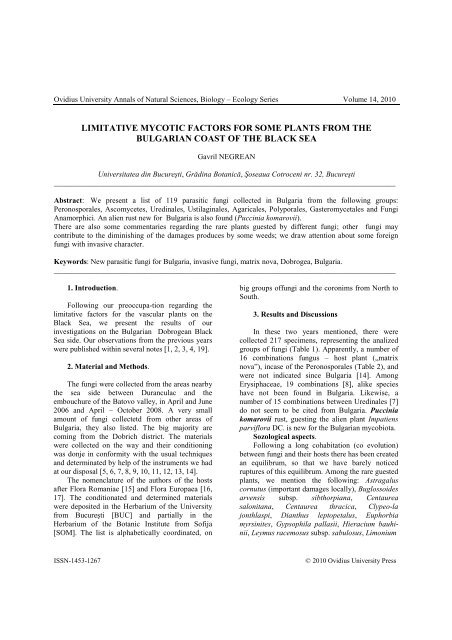VOLUM OMAGIAL - Facultatea de Ştiinţe ale Naturii şi Ştiinţe Agricole
VOLUM OMAGIAL - Facultatea de Ştiinţe ale Naturii şi Ştiinţe Agricole
VOLUM OMAGIAL - Facultatea de Ştiinţe ale Naturii şi Ştiinţe Agricole
Create successful ePaper yourself
Turn your PDF publications into a flip-book with our unique Google optimized e-Paper software.
Ovidius University Annals of Natural Sciences, Biology – Ecology Series Volume 14, 2010<br />
LIMITATIVE MYCOTIC FACTORS FOR SOME PLANTS FROM THE<br />
BULGARIAN COAST OF THE BLACK SEA<br />
Gavril NEGREAN<br />
Universitatea din Bucureşti, Grădina Botanică, Şoseaua Cotroceni nr. 32, Bucureşti<br />
__________________________________________________________________________________________<br />
Abstract: We present a list of 119 parasitic fungi collected in Bulgaria from the following groups:<br />
Peronospor<strong>ale</strong>s, Ascomycetes, Uredin<strong>ale</strong>s, Ustilagin<strong>ale</strong>s, Agaric<strong>ale</strong>s, Polypor<strong>ale</strong>s, Gasteromycet<strong>ale</strong>s and Fungi<br />
Anamorphici. An alien rust new for Bulgaria is also found (Puccinia komarovii).<br />
There are also some commentaries regarding the rare plants guested by different fungi; other fungi may<br />
contribute to the diminishing of the damages produces by some weeds; we draw attention about some foreign<br />
fungi with invasive character.<br />
Keywords: New parasitic fungi for Bulgaria, invasive fungi, matrix nova, Dobrogea, Bulgaria.<br />
__________________________________________________________________________________________<br />
1. Introduction.<br />
Following our preoccupa-tion regarding the<br />
limitative factors for the vascular plants on the<br />
Black Sea, we present the results of our<br />
investigations on the Bulgarian Dobrogean Black<br />
Sea si<strong>de</strong>. Our observations from the previous years<br />
were published within several notes [1, 2, 3, 4, 19].<br />
2. Material and Methods.<br />
The fungi were collected from the areas nearby<br />
the sea si<strong>de</strong> between Duranculac and the<br />
embouchure of the Batovo valley, in April and June<br />
2006 and April – October 2008. A very small<br />
amount of fungi collectetd from other areas of<br />
Bulgaria, they also listed. The big majority are<br />
coming from the Dobrich district. The materials<br />
were collected on the way and their conditioning<br />
was donje in conformity with the usual techniques<br />
and <strong>de</strong>terminated by help of the instruments we had<br />
at our disposal [5, 6, 7, 8, 9, 10, 11, 12, 13, 14].<br />
The nomenclature of the authors of the hosts<br />
after Flora Romaniae [15] and Flora Europaea [16,<br />
17]. The conditionated and <strong>de</strong>termined materials<br />
were <strong>de</strong>posited in the Herbarium of the University<br />
from Bucureşti [BUC] and partially in the<br />
Herbarium of the Botanic Institute from Sofija<br />
[SOM]. The list is alphabetically coordinated, on<br />
big groups offungi and the coronims from North to<br />
South.<br />
3. Results and Discussions<br />
In these two years mentioned, there were<br />
collected 217 specimens, representing the analized<br />
groups of fungi (Table 1). Apparently, a number of<br />
16 combinations fungus – host plant („matrix<br />
nova”), incase of the Peronospor<strong>ale</strong>s (Table 2), and<br />
were not indicated since Bulgaria [14]. Among<br />
Erysiphaceae, 19 combinations [8], alike species<br />
have not been found in Bulgaria. Likewise, a<br />
number of 15 combinations between Uredin<strong>ale</strong>s [7]<br />
do not seem to be cited from Bulgaria. Puccinia<br />
komarovii rust, guesting the alien plant Impatiens<br />
parviflora DC. is new for the Bulgarian mycobiota.<br />
Sozological aspects.<br />
Following a long cohabitation (co evolution)<br />
between fungi and their hosts there has been created<br />
an equilibrum, so that we have barely noticed<br />
ruptures of this equilibrum. Among the rare guested<br />
plants, we mention the following: Astragalus<br />
cornutus (important damages locally), Buglossoi<strong>de</strong>s<br />
arvensis subsp. sibthorpiana, Centaurea<br />
salonitana, Centaurea thracica, Clypeo-la<br />
jonthlaspi, Dianthus leptopetalus, Euphorbia<br />
myrsinites, Gypsophila pallasii, Hieracium bauhinii,<br />
Leymus racemosus subsp. sabulosus, Limonium<br />
ISSN-1453-1267 © 2010 Ovidius University Press





